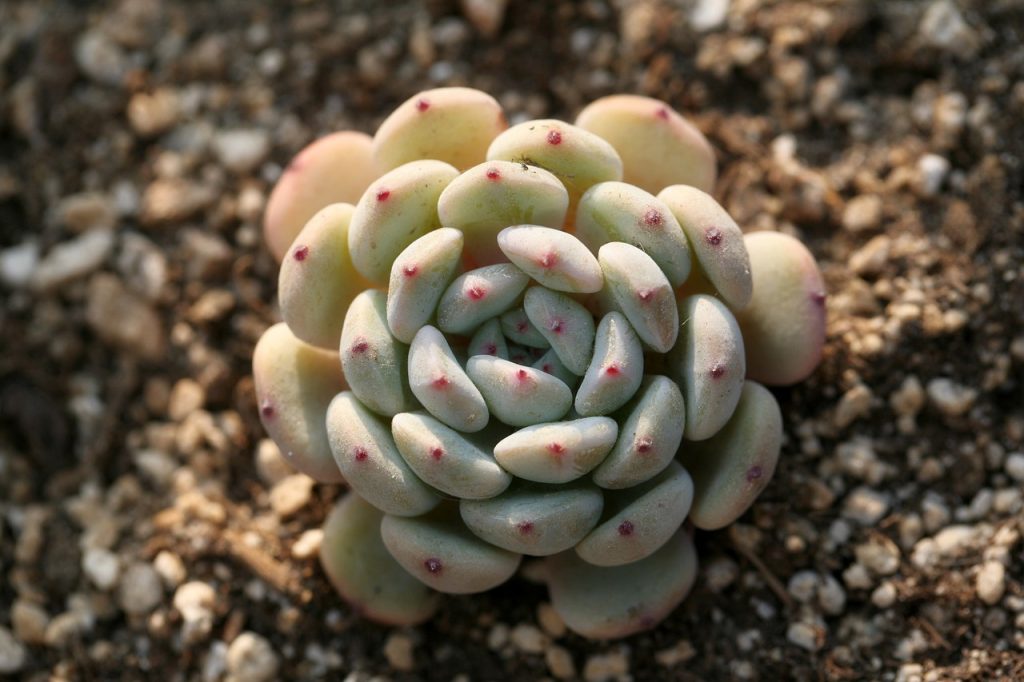Because succulents are commonly found in deserts or sandy areas, many have asked whether or not succulents can survive without soil, just in sand. And my quick answer to the question in yes. Definitely. However, succulents thrive longer in potting soil. The ideal potting mix should contain a mixture of 1/3 sand and 2/3 potting soil.
The reason why the combination of sand and potting soil works well for succulents is that soil provides moisture and nutrients, while the sand allows the water to drain faster leaving the roots healthy, free of rot, which is a common problem succulent growers experience. Mixing your succulent soil with sand is a superb idea.
However, the versatility of succulents depends on the variety you are planting. Some succulents can thrive in dense sand, and now I will show you some examples. These succulents are not only versatile but also beautiful. They produce colorful flowers. Let’s move to the three categories.
Table of Contents
Ground cover succulents
As the name suggests, this type of succulents tends to spread over the ground as it grows. It literally covers the ground with beautiful leaves. One of the Ground Cover succulents is the Rose Moss (Portulaca Grandiflora). It blooms from spring to fall. This type of succulent does not grow tall. Usually, it grows for about 6 inches tall and produces light green leaves color with flowers comparable to rose.
Another ground cover succulent is the Ice Plant (Delosperma Cooperi). Like the Rose Moss, this succulent also blooms from spring to fall. It grows 3-6 inches tall with green leaves. Unlike the Rose Moss, this succulent produces reddish-purple daisy-like flowers. However, these two types of succulents can grow and thrive in sandy soil. If you are living nearby sea, and you are wondering what succulent to start with, the Ground Cover Succulents can the best choice.

Border succulents
If you want succulents that are not only capable of surviving in the sand but also capable of thriving in drought or hot environment, then maybe you want to consider the Showy Sedum and Myrtle Euphorbia. Showy Sedum also is known as Hylotelephium Spectabile or Showy Stonecrop is one of the most resistant succulents when it comes to high temperature and drought. This plant grows a little bit bigger than the previous types. It normally grows up to 2 feet high and wide. The flower can grow up to 6 inches wide.
Another good succulent for this category is the Donkey Tail also known as the Myrtle Euphorbia or Euphorbia Myrsinites. This one is bigger than the Showy Sedum which height can reach up to 6-12 inches. This succulent blooms in the spring and produces yellow flowers. Both succulent types are versatile and could perfectly thrive under the full sun. They love dense sand that allows water to drain easily, just as it does in their native land.
Succulent shrubs
Other types of succulents that can perfectly grow in the sand are the Crown of Thorns (Euphorbia Milii) and Inkberry (Scaevola Plumieri) commonly known as beach berry, fan flower, half-flower, and gullfeed. These succulent shrubs can grow in dense sand.
As the name suggests, the Crown of Thorns are thorny succulents and have light green foliage. These succulents can have different flower colors such as pink, red, yellow, white, and orange. They can grow under full sunlight or in shade. These types of succulents, however, may not grow in salty soil.
The Inkberry succulents, on the other hand, have dark green fleshy foliage. These succulents can grow up to 3 feet in height. They bloom from spring to winter and produce blackberries. Unlike the Crown of Thorns, Inkberry Bushes can grow in salty soil. They are perfect plants nearby seashore.
Some taller succulents can also thrive in sand
The succulents mentioned above are only a few varieties that can grow in sand. There are other types of succulents that can thrive in sandy soil. But the reason why we did not include here is that those types are the taller succulents.
Most our readers love succulents that stay small. Those succulents that we did not include in this post are capable of thriving in sandy soil but they grow up to several feet high–which isn’t ideal for my garden. Of course, this is our personal preference. If you are looking for succulents that grow tall and thrive in sand, check other resources online.
If you live near the seashore, you need succulents that can tolerate salty wind and soil. The three types of succulents mentioned above are your best bet in this case…
Can you use sand for outdoor succulents?
You have to remember that sand does not contain nutrients necessary for your succulents. Soil does. However, pure soil is not a perfect potting material either. This is because the soil holds too much water for the liking of a succulent.
Having said that, the sand is only an important component of a perfect potting material, not the only ingredient. Perfect potting mix is a combination of sand and soil. The sand provides better drainage while the soil provides nutrients. If you are looking for a perfect potting mix, you can consider the one that we recommend–recommended soil mix from Amazon.
Final thoughts
Before planting your succulents, it is very important to know what type of succulents you have. This is the first step in growing your succulents successfully. Remember that not all types of succulents can thrive and grow in sand. If you go with one of the varieties we mentioned here, however, you can definitely achieve excellent results with your plants growing in dense sand. Hope this helps, and do not forget to check also our complete guide on how to grow succulents. Thank you!
